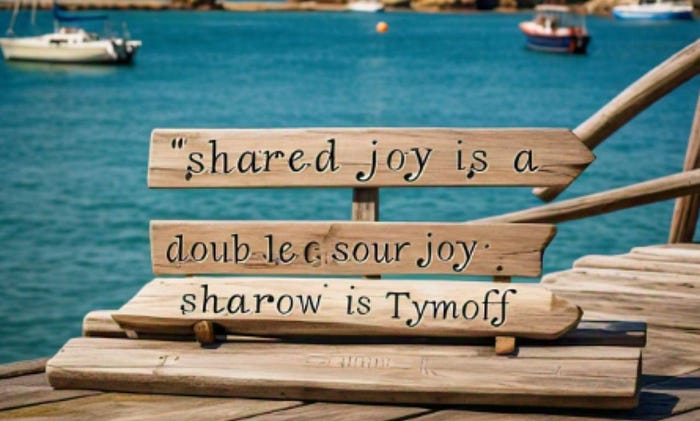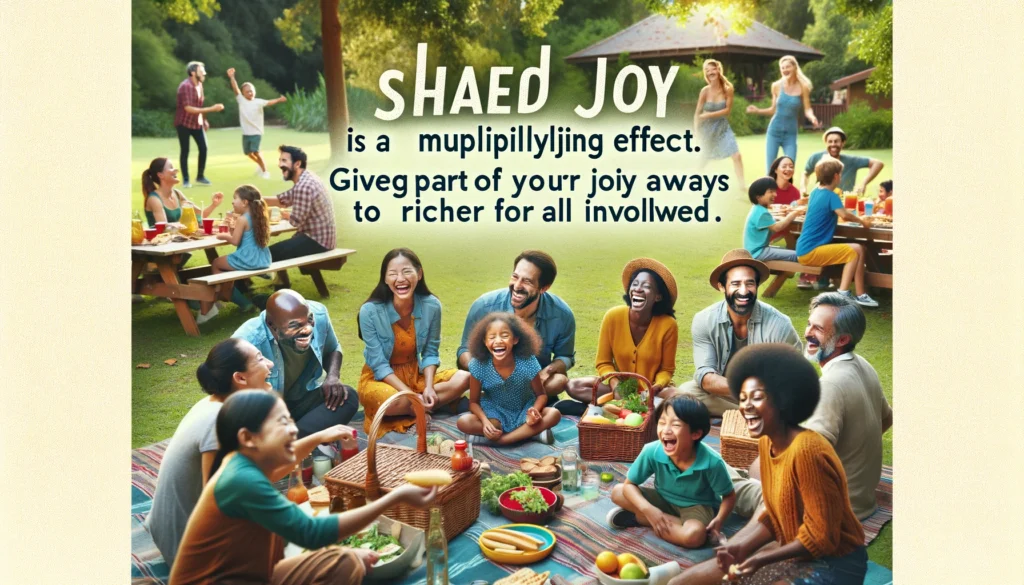The phrases shared joy is a double joy; shared sorrow is tymoff encapsulate the profound impact of community and connection on our emotional experiences. In this article, we will delve into the meaning of these expressions, exploring the psychological and social dimensions of sharing both joyful and sorrowful moments. By understanding these concepts, we can cultivate deeper relationships and enhance our emotional well-being.
Understanding the Concepts of Shared Joy and Shared Sorrow

What Does “Shared Joy is a Double Joy” Mean?
The phrase shared joy is a double joy; shared sorrow is tymoff suggests that when happiness is shared, it amplifies the experience, making it richer and more fulfilling. Joy, by its nature, is often heightened when it is expressed with others. This concept can be understood from various perspectives, including psychological, social, and cultural.
The Psychological Aspect of Shared Joy
Psychologically, sharing joyful moments can enhance our happiness. Research has shown that social connections play a crucial role in our overall well-being. When we share joyful experiences, we validate our emotions and create lasting memories. This shared joy can act as a buffer against stress and anxiety, allowing individuals to feel more connected and fulfilled.
The Social Dynamics of Sharing Joy
Socially, when we share joy, we strengthen our relationships. Celebrations, whether big or small, create bonds between people. Events like weddings, birthdays, and holidays serve as perfect examples of how shared joy fosters community and enhances our social networks. The act of celebrating together fosters an environment of support, gratitude, and appreciation.
The Importance of Shared Experiences

The Role of Shared Joy in Personal Development
Sharing joy not only enriches our lives but also contributes to personal development. When we engage in joyful activities with others, we learn more about ourselves and our relationships.
Building Confidence Through Shared Joy
Participating in group activities, such as team sports or community projects, allows individuals to experience collective success. This shared achievement can boost self-esteem and confidence, reinforcing the notion that we are not alone in our pursuits. In this way, shared joy is a double joy; shared sorrow is tymoff becomes a catalyst for personal growth.
Learning from Others’ Joys
When we witness others’ happiness, we can learn from their experiences. Observing how others navigate joy can offer insights into our own lives, providing inspiration and motivation to pursue our own happiness. This exchange of experiences deepens our understanding of what brings joy and how to cultivate it in our lives.
Exploring the Concept of Shared Sorrow

What Does “Shared Sorrow is Tymoff” Mean?
On the flip side, shared joy is a double joy; shared sorrow is tymoff indicates that sharing sorrow can lighten the burden of pain. When we face difficulties, sharing our experiences with others can provide solace and support. The term “tymoff” refers to the idea that while sorrow is a heavy emotion, sharing it can mitigate its intensity.
The Psychological Benefits of Shared Sorrow
From a psychological perspective, sharing sorrow allows individuals to process their emotions in a supportive environment. Talking about our pain with trusted friends or family can foster healing. It validates our feelings and reminds us that we are not alone in our struggles. This act of sharing can lead to catharsis, allowing us to release pent-up emotions and find closure.
Strengthening Bonds Through Shared Sorrow
When we share our sorrows, we often find that others can relate to our experiences. This commonality creates a sense of belonging and understanding. For instance, support groups for grief or illness allow individuals to connect over shared experiences, forming bonds that can last a lifetime. In these moments, shared joy is a double joy; shared sorrow is tymoff highlights the power of empathy and connection.
The Balance Between Joy and Sorrow

Finding Harmony in Life’s Experiences
Life is a balance of joy and sorrow. Embracing both aspects can lead to a more fulfilling existence. Understanding that shared joy is a double joy; shared sorrow is tymoff allows us to appreciate the full spectrum of human emotion.
The Role of Resilience
Resilience plays a critical role in navigating the ups and downs of life. When we share our joys and sorrows, we build resilience together. Supportive relationships enable us to bounce back from adversity, knowing we have a network to rely on during tough times.
Creating a Culture of Sharing
Cultivating a culture where individuals feel safe to share their experiences, both joyful and sorrowful, enhances community well-being. Encouraging open conversations about emotions can help dismantle stigma and foster deeper connections. This culture emphasizes the importance of saying, “I understand,” and “You are not alone,” reinforcing the notion that shared joy is a double joy; shared sorrow is tymoff.
Practical Ways to Foster Shared Joy and Sorrow

Building Communities of Connection
Creating spaces for shared experiences is essential for enhancing our emotional lives. Here are some practical ways to foster shared joy and sorrow in our communities.
Organizing Community Events
Community events like potlucks, festivals, or family gatherings provide opportunities for shared joy. These occasions allow people to come together, celebrate, and create lasting memories. When people share laughter and joy, they build stronger ties that can also support them in times of sorrow.
Encouraging Support Groups
Support groups for various challenges—grief, illness, or even hobbies—encourage individuals to share their experiences. This fosters an environment where shared sorrow becomes a source of strength. Facilitating these groups can help individuals find solace in their shared experiences, leading to collective healing.
The Impact of Technology on Shared Experiences

Digital Connection and Emotional Sharing
In today’s digital age, technology plays a vital role in how we share our joys and sorrows. Social media, video calls, and messaging apps enable us to stay connected, regardless of physical distance.
The Pros and Cons of Sharing Online
While online platforms can enhance our ability to share, they also come with challenges. On one hand, social media allows for immediate sharing of joyful moments, fostering community and celebration. On the other hand, it can lead to superficial connections, where sharing becomes more about image than genuine emotion. Balancing online sharing with authentic interactions is key.
Virtual Support Networks
In times of crisis, virtual support networks have become invaluable. Online forums and groups allow individuals to share their experiences of sorrow and receive support from others who understand their pain. This digital connection exemplifies the essence of shared joy is a double joy; shared sorrow is tymoff in a modern context.
The Cultural Context of Sharing Emotions

Cultural Differences in Sharing Joy and Sorrow
Different cultures have unique approaches to sharing joy and sorrow. Understanding these differences can enrich our perspective on emotional sharing.
Celebrations Around the World
In many cultures, communal celebrations are integral to sharing joy. Festivals, religious holidays, and local traditions often revolve around gathering as a community to rejoice. These shared experiences deepen connections and promote a sense of belonging.
Mourning Practices and Community Support
Cultural mourning practices also highlight the importance of shared sorrow. In some cultures, communal mourning rituals are essential for processing grief. These practices allow individuals to collectively honor their loss, illustrating the profound impact of shared joy is a double joy; shared sorrow is tymoff in navigating life’s challenges.
Personal Stories and Anecdotes

Real-Life Examples of Shared Joy and Sorrow
Personal stories often illustrate the power of shared experiences. Here are a few anecdotes that highlight the impact of shared joy is a double joy; shared sorrow is tymoff.
A Celebration of New Life
Consider a family who comes together to celebrate the birth of a new child. The joy of welcoming a baby into the family creates an atmosphere of love and happiness. Each shared smile and hug amplifies the joy, reinforcing the bond between family members.
Healing After a Loss
On the other hand, a group of friends who gather to support a loved one after a loss exemplifies shared sorrow. In sharing their grief, they create a supportive network, allowing each person to express their feelings openly. This collective mourning emphasizes that while sorrow is heavy, sharing it makes it lighter.
Strategies for Enhancing Emotional Sharing

Practical Tips for Cultivating Shared Joy and Sorrow
To foster an environment where shared experiences are the norm, consider the following strategies:
Practice Active Listening
Listening actively when others share their joys or sorrows is essential. Validate their emotions and provide a safe space for expression. This practice reinforces the idea that shared joy is a double joy; shared sorrow is tymoff, creating deeper connections.
Create Rituals for Sharing
Establishing rituals, such as regular family dinners or community meet-ups, encourages sharing both joy and sorrow. These rituals create a consistent space for emotional expression and connection.
Encourage Vulnerability
Promote an atmosphere where vulnerability is accepted and celebrated. Encourage friends and family to share their feelings without fear of judgment. This openness strengthens relationships and reinforces the significance of shared joy is a double joy; shared sorrow is tymoff.
The Future of Shared Experiences

Embracing a Culture of Sharing
As society continues to evolve, the importance of sharing joy and sorrow will remain vital. Embracing a culture that values emotional connection can lead to healthier, more supportive communities.
Advocating for Mental Health Awareness
Raising awareness about mental health can enhance understanding of the importance of shared experiences. Encouraging open discussions about emotions fosters environments where individuals feel comfortable sharing their joys and sorrows.
Building Stronger Communities
Investing in community-building initiatives can enhance opportunities for shared experiences. Workshops, events, and support groups that focus on emotional sharing can create more cohesive and resilient communities.
Conclusion: The Lasting Impact of Shared Experiences

In conclusion, the expression shared joy is a double joy; shared sorrow is tymoff encapsulates the essence of human connection. By sharing our experiences, both joyful and sorrowful, we foster deeper relationships, build resilience, and enhance our emotional well-being.
Embracing the power of shared experiences allows us to navigate life’s complexities with greater ease. Whether through celebrations or support, recognizing that we are not alone in our feelings can lead to a more fulfilling life. As we continue to cultivate connections, let us remember the profound impact of sharing our joys and sorrows with one another.


